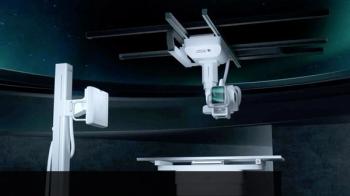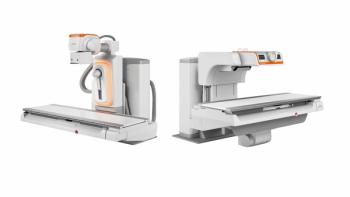
CR vendors challenge DR with novel research efforts
Computed radiography has long had a financial edge over its flat-panel competitor, digital radiography. Radiography departments can convert to digital with the introduction of a single high-performance CR reader, as opposed to swapping film-based units for those with DR plates.
Computed radiography has long had a financial edge over its flat-panel competitor, digital radiography. Radiography departments can convert to digital with the introduction of a single high-performance CR reader, as opposed to swapping film-based units for those with DR plates.
An undercurrent of this financial argument is the perception that CR is an older, technologically in-ferior modality that will fade into oblivion with DR's inevitable progress. CR vendors, however, don't see it that way.
Agfa, Fuji, Kodak, and Konica Minolta are tweaking CR's image processing software and underlying hardware to deliver performance comparable to DR in image quality and even workflow. The results have improved CR, in some cases placing it in direct technological competition with DR and potentially changing its status to long-term contender.
The imaging plate, CR's equivalent to the DR flat-panel detector, is a major focus of these efforts. CR engineers are working on the lasers that stimulate release of radiographic information from the plates and the optics that record that information. They are also optimizing the particle sizes of phosphors, the binder that holds the particles together, and the thickness of the coating to achieve increased efficiency.
Generally, the larger the particles, the better the absorption of x-rays. But larger particles present problems in reading the plates because they scatter more than smaller par-ticles, causing more noise in the image.
"Finding the right balance of particle sizes and the distribution of those particles is very important to the design characteristics," said Tim Wojcik, Kodak's program leader responsible for radiographic image capture technology.
These balances differ according to application. General radiography, for example, requires higher contrast and less resolution than extremity imaging. Plates for general radiography, therefore, emphasize x-ray absorption, whereas those intended for extremity imaging, which requires high resolution, emphasize noise reduction at the expense of x-ray absorption.
Kodak engineers have determined the balances they believe are optimal for each. They have developed means for translating those equations into a tightly controlled manufacturing process to ensure compliance in the final products.
Agfa has gone a step further, delving into the underlying chemistry of the plates and reformulating the storage phosphor itself. Conventional CR uses phosphor deposited on the plates as a powder. Agfa has reconstituted its storage phosphor to assume the shape of microscopic needles. During the reading process, these needles absorb energy from laser diodes and emit light in a specific direction. Powder phosphor emits light in all directions. The preferential emission of light achieved with needle phosphor improves the sharpness of the images.
Agfa achieved this novel shape by formulating cesium bromide, a new type of phosphor. Cesium iodide, a related phosphate, is widely used in image intensifiers and as the scintillator in DR detectors that use amorphous silicon. Cesium iodide, however, is not a storage phosphor; when struck by an x-ray, it emits light immediately, rather than storing the energy.
"For years, people have tried to make CR materials that have the same properties, but without much luck," said Ralph Schaetzing, Ph.D., technical director of digital imaging at Agfa Healthcare. "We did a lot of searching through the periodic table, trying to find the appropriate material with the right storage properties, and it turns out we found a pretty good one."
The needles of cesium bromide improve not only the sharpness of images but the erasability of the plates, so remnant images from previous exposures can be cleaned off more easily. The shape of the phosphor also allows Agfa to use a thicker coating on the plate, which improves x-ray absorption. This boosts CR performance to the level of DR, according to Schaetzing.
"When you start comparing DQE (detective quantum efficiency), the usual metric that people talk about, we are up there with DR, where-as conventional CR is about a factor of two lower," he said.
The light emission qualities of needle phosphor would not be fully realized if not for the ScanHead optical system that reads the plates line by line rather than point by point, as is usually done in CR. This linear system uses a string of laser diodes to stimulate the phosphor and a matched line of CCDs to record the emitted light.
Agfa launched its needle phosphor plates and reading technology at the 2004 RSNA meeting as part of its CR 50.0. The single-plate reader has an estimated throughput of 130 plates per hour. The company also improves image quality through its MUSICA (multiscale image contrast amplification) software. MUSICA increases contrast and sharpens detail by breaking the image data set into different "layers" of resolution, processing each one individually and then recombining them.
Konica Minolta promises to improve image quality and workflow with its IQue. The dual-bay CR reader, based on the Xpress CR, features an "intelligent" user interface that automatically recognizes different exam views and optimizes the image quality.
"All you would have to do, for example, is select 'lower extremity,' and it will figure out if you are looking for a knee or tibia," said Eunice K. Lin, CR marketing manager for Konica Minolta Medical Imaging.
The software eases the transition from film- to CR-based imaging because it reduces the risk that less skilled technologists will produce lower quality images.
"It simplifies the learning process tremendously, so you don't have to know a lot of processing algorithms. It is all built in," Lin said.
Kodak's Health Group research laboratory is also focusing on practical matters, emphasizing the development of CR systems that work in distributed environments. Practicality dictates that these systems be compact but still support traditionally sized cassettes. These parameters led to the development of the company's CR 500 single-plate reader, released at the 2003 RSNA meeting.
"The target was to come out with something that is more compact and also delivers better image quality. That caused us to do a co-design of the screen and reader," Wojcik said.
Kodak developed a flexible screen for its 14 x 17-inch imaging plate and a curved transporter to shrink the footprint of the reader. It has also designed what it calls a long-length imaging system, an extremity imaging product that includes five CR-compatible buckys and image stitching software.
"The idea is to do a simultaneous capture of multiple CR plates in such a way that you can reconstruct a larger composite image that allows full leg or full spine images, the two exam types that typically utilize this technology," said Dave Foos, director of the Kodak Health Group's research laboratory.
Technological development complements Kodak's corporate moves, such as its acquisition earlier this year of Orex. That company's small-format CR products address orthopedics, imaging centers, and dentistry.
Although committed to CR, Kodak has hedged its bets by developing flat-panel DR technology that balances its line of CR products. Fuji, on the other hand, has placed all its bets on CR, which has led to a markedly different strategy.
Five years ago, Fuji released a CR-based product designed to compete head to head with DR systems. The FCR 5502D Digital Table was a cassetteless CR unit that recorded radiographic images on multiple plates contained within it. The company later released the ClearView-D, an upright configuration.
Fuji's latest step in this direction has reduced the number of plates to one. HD LineScan advanced optics read the plate line by line rather than point by point. The technology, similar to Agfa's, uses multiple laser diodes coupled with high-capacity CCDs to capture whole lines of data. Fuji has also modified the imaging plate to include a thicker than usual coating of phosphor to accommodate faster scanning and erasure.
"We are able to use storage phosphor as the detector, so there is a great cost advantage in terms of development. Yet it allows you to achieve the same workflow as DR by eliminating the use of cassettes," said Penny Maier, national marketing manager for Fuji Digital X-ray.
The new design reduces the footprint of the unit and confers an advantage in speed compared with Fuji's first generation of cassetteless products. Images are displayed in nine seconds, and as many as 240 images can be processed and displayed per hour.
This Velocity FCR product line is available in two configurations. Velocity-U, designed for upright operation, began shipping in the U.S. in April 2004. Velocity-T, the table version, first arrived at U.S. sites in January 2005. The Velocity products can be used to retrofit existing film-based systems, or they can be purchased as fully integrated, turnkey SpeedSuite products.
R&D is rapidly narrowing the differences between CR and DR. CR is taking the place of flat panels in table and upright radiography systems, and "hardened" flat-panel detectors are being built into portable x-ray devices.
In competing directly with DR, however, CR cedes ground in its battle for financial preeminence. CR-based Velocity FCRs bring individual suites rather than whole radiography departments into the digital age, reducing the financial bang for the buck.
Chemical engineers at these vendors are often caught between a particle and a hard place. Mechanical engineers face similar challenges, as they attempt to find the sweet spot between structure and function.
Newsletter
Stay at the forefront of radiology with the Diagnostic Imaging newsletter, delivering the latest news, clinical insights, and imaging advancements for today’s radiologists.




























